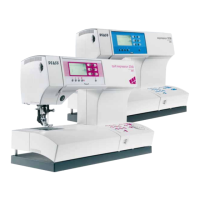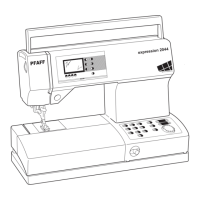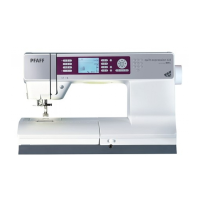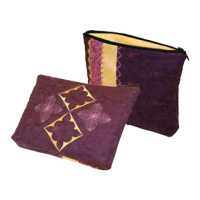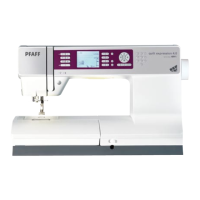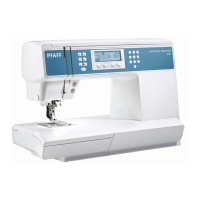Do you have a question about the Pfaff expression 2034 and is the answer not in the manual?
Safety precautions regarding electric shock from sewing machine operation.
General safety warnings for operating the sewing machine, especially around children.
Instruction to save safety guidelines for future reference.
Notes on safety standards, recommended environment, and care.
Guidance on protecting the machine from damage and cleaning instructions.
Introduction to the machine's modern design and push-button controls.
List of all headings and their corresponding page numbers in the manual.
Identification and numbering of components for sewing machine models 2044 and 2034.
Instructions for electrical connection, voltage switch, bobbin winding, tension, and threading.
Details on presser foot lifter, thread cutter, needle changes, IDT, and feed dog.
Instructions on using the carrying case and lid with stitch chart.
Connecting the machine to power, foot control, and master switch.
Guidance on setting the voltage switch for different power supplies.
How to open, use, arrange accessories in the tray, and accessory list.
Procedure for removing tray and preparing for bobbin winding.
Instructions for winding bobbin from spool pin and threading the machine.
Step for switching on the master switch to begin sewing.
How to wind from a second spool holder and thread the machine.
Procedure to turn on the master switch to begin operation.
Instructions for bobbin door, case removal, and tension adjustment guide.
How to insert, check, and correct bobbin case tension.
How to use presser foot lifter, draw up bobbin thread, and use thread cutter.
Instructions for closing the bobbin door and pulling thread.
Procedure for changing presser feet and setting needle tension.
Procedure for removing and inserting sewing machine needles.
Instructions for threading the machine with a twin needle.
How to activate and deactivate the Integrated Dual Feed system.
Adjusting contrast, selecting stitches, and using stitch monitor.
How to alter stitch width, length, density, and pattern size.
Information on Balance, Lock button, Twin needle, and stitch formation.
How to adjust screen contrast for optimal visibility.
Methods for selecting stitches using wheels and buttons.
Explanation of the bobbin thread level indicator.
How to adjust stitch parameters like length, width, and density.
How to use the info button to get stitch details.
Functions of the reverse sewing button, including manual finish.
How to use tie-off and needle up/down buttons.
Using the sew slow and pattern mirror buttons.
How to safeguard and deactivate the lock function.
Overview of managing, storing, deleting sequences, and related buttons.
Instructions for storing, deleting stitches, and managing memories.
Details on buttons used for managing stitch sequences.
How to access and open memory slots for stitch sequences.
How to insert a new stitch into an existing sequence.
Procedure to add a stitch at the start of a sequence.
How to delete an entire stitch sequence by clearing the memory.
Procedure to delete all stored stitch memories at once.
How to alter stitch length or width within a stored sequence.
Using the pattern start function to resume interrupted sewing.
Stitches for non-elastic/elastic, overlock, hemming, and shell edging.
Stitches for zippers, buttons, darning, gathering, bridging, and cross-hem.
Details on the basic straight stitch and its applications.
Instructions for sewing zippers using appropriate stitches and feet.
How to use the basting stitch for temporary fabric holding.
Techniques for topstitching using the straight stitch.
Using a feed aid for precise feeding of thick seams.
Instructions for creating invisible hems.
How to sew blind hems on stretchy fabrics.
Using the zigzag stitch for finishing raw edges.
How to use the stretch triple zigzag for elastic seams.
Using the stretch triple straight stitch for strong seams.
How to use the elastic stitch for adding elastic.
Creating elastic and decorative hems with honeycomb stitch.
Using the elastic stitch for repairing fabric holes and tears.
How to repair larger holes by sewing on patches.
Techniques for repairing fabric tears and small holes.
Overview of overlock stitches for elastic and stretch fabrics.
Using the closed overlock stitch for fabrics that fray easily.
How to use the open overlock stitch for joining fabrics.
Using closed overlock with selvage thread and pullover stitch.
Instructions for sewing on two and four-hole buttons.
How to sew on buttons with shanks.
How to stitch eyelets on fabric using stitch 72.
Using automatic darning for fabric repair and strengthening.
Using the straight stitch for gathering fabric.
How to gather fabric using elastic threads.
Creating hemstitching effects with bridging and cross hem stitches.
How to use the light-knit mending stitch for stretchy seams.
Using the hemmer attachment to create rolled hems.
Using zigzag stitch 3 for rolled hems on stretch fabrics.
General tips, installing guide, and attaching buttonhole foot.
Overview of types and automatic, semi-automatic, manual sewing methods.
Reinforcing buttonholes with gimp thread and tips for perfection.
Introduction to capabilities and steps to install the buttonhole guide.
How to attach the specialized buttonhole foot.
Details on linen, stretch, and round buttonholes.
Instructions for sewing keyhole buttonholes.
Procedure for sewing buttonholes automatically.
How to sew buttonholes semi-automatically.
Instructions for manually sewing buttonholes.
Properly sewing keyhole buttonholes with correct orientation.
Detailed steps for manually sewing buttonholes.
Properly sewing keyhole buttonholes with correct orientation.
List and description of standard and special presser feet.
Details on felling, pintuck, cording, knit edge, and other specialty feet.
Information on fringe, narrow edge, 7/9 hole, braiding, and embroidery guides.
Reference for different needle types and their uses.
Description of standard, fancy stitch, and blind stitch feet.
Details on zipper, buttonhole, darning, and roll hemmer feet.
Description of edge guide and sensormatic buttonhole guide.
Information on bulb remover, seam ripper, brush, oil, and needle box.
Details on bobbins and various spool caps.
Details on appliqué, bias binder, pintuck, and fringe feet.
Information on straight stitch, needle plates, felling, shirring, and ruffler feet.
Details on cording, eyelet, hemmer, knit-edge, non-stick, and embroidery feet.
Information on the circular embroidery guide.
Details on bridging guide and quilt/patchwork feet.
Information on pintuck, braiding, 7/9 hole, and narrow edge feet.
Details on free motion, quilt guides, and other specialty feet.
Instructions for using the felling foot for strong seams.
How to use the appliqué foot for creating decorative effects.
How to use the cording foot for purl seams and decorative effects.
Instructions for using the shirring/gathering foot for decorative gathers.
Using the knit edge foot for thick seams in knitted fabrics.
How to use the ruffler for creating pleats and ruffles.
Instructions for using the 1/4 inch quilt/patchwork foot for piecing.
Techniques for joining quilt layers using machine stitches.
How to use the free-motion quilt foot for quilting and embroidery.
Instructions for binding fabric edges with bias tape.
How to use the pintuck foot with guide for precise spacing.
Using the non-stick foot for sewing on leather and vinyl.
How to use the 7/9 hole foot for decorative effects with cords.
Instructions for using the braiding foot for heavy cords or ribbons.
Using the fringe foot for creating fringe embroidery effects.
How to use narrow edge and stitch-in-the-ditch feet for topstitching.
Techniques for narrow-edge topstitching and sewing lace.
General tips for achieving decorative stitching effects.
How to adjust pattern width and length for borders.
Creating decorative borders by combining stitches and using twin needles.
How to create monograms and perform free-motion embroidery.
Techniques for tapering, appliqué, quilting, cross-stitch, eyelets, and hemstitching.
Creating decorative borders by combining different stitches.
Using a twin needle for decorative border effects.
Techniques for tapering with satin-stitch zigzag.
How to manually adjust zigzag stitch width for tapering.
Manually creating irregular patterns with zigzag stitch tapering.
Using automatic tapering for corners and borders.
Continuing instructions for automatic tapering.
Creating a decorative variation of the linen buttonhole.
Introduction to patchwork and quilting techniques.
Using quilt stitches 11 and 15 for a hand-quilted look.
Steps for preparing and piecing quilt tops.
How to perform stitch-in-the-ditch quilting for securing layers.
Securing quilt layers using decorative stitches for tying.
Instructions for free motion stippling for texture and interest.
Techniques for creating hemstitching effects.
Steps for performing traditional hemstitching.
Procedure for changing the needle plate and sewing lamp bulb.
Instructions for cleaning and oiling the sewing machine.
Troubleshooting common sewing issues.
Procedure for removing the old and installing the new light bulb.
Troubleshooting skipped stitches, thread breaks, and needle breakage.
Identifying and fixing causes of uneven seams and thread issues.
Troubleshooting feed issues, operational difficulty, and stitch selection.
Resolving issues with the sewing machine's display.
Procedure for changing the needle plate.
Instructions for cleaning the machine and display.
Procedure for removing and installing the light bulb.
Troubleshooting skipped stitches, thread breaks, and needle breakage.
Identifying and fixing causes of uneven seams and thread issues.
Troubleshooting feed issues, operational difficulty, and stitch selection.
Resolving issues with the sewing machine's display.
Dimensions, weight, voltage, power, speed, and stitch ranges.
List of items included in the sewing machine package.
| Brand | Pfaff |
|---|---|
| Model | expression 2034 |
| Category | Sewing Machine |
| Language | English |
